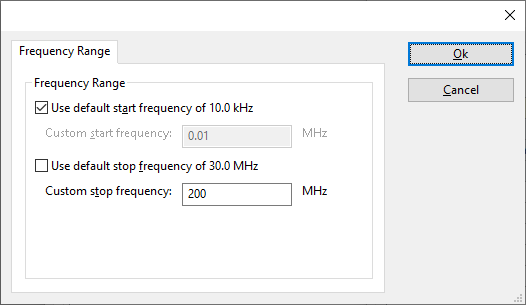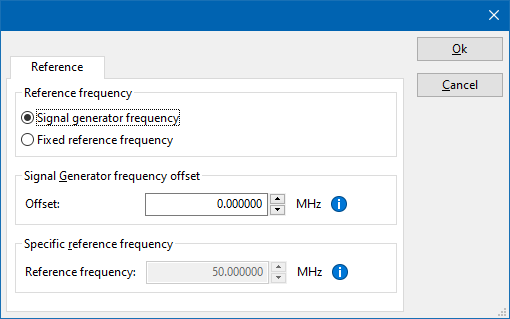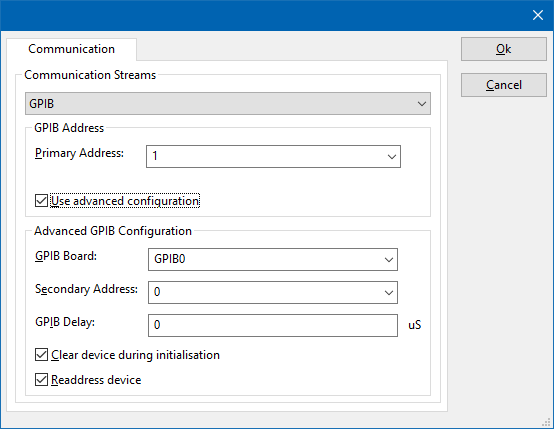
|
Note:
|
This page is used to show the configuration of the LeCroy oscilloscope device drivers. This page can now easily be embedded on all relevant device driver pages.
|
The following tabs are available in the advanced configuration of the LeCroyOscilloscopeDeviceDriverConfiguration:

The frequency range of the LeCroyOscilloscopeDeviceDriverConfiguration as provided by the manufacturer is shown and selected as default. It is possible to overrule these frequencies and to manually adjust the allowed frequency range of the LeCroyOscilloscopeDeviceDriverConfiguration.
 Use default start frequency Use default start frequency
|
If the checkbox is checked, the default start frequency will be used as the lowest usable frequency in a test for this device.
|
 Custom start frequency Custom start frequency
|
If the Use default start frequency checkbox is unchecked, another start frequency (expressed in MHz) can be specified. The customized start frequency will then be used as the lowest usable frequency in a test for this device. The customized frequency can be a limitation or an extension of the default start frequency.
|
 Use default stop frequency Use default stop frequency
|
If the checkbox is checked, the default stop frequency will be used as the highest usable frequency in a test for this device.
|
 Custom stop frequency Custom stop frequency
|
If the Use default stop frequency checkbox is unchecked, another stop frequency (expressed in MHz) can be specified. The customized stop frequency will then be used as the highest usable frequency in a test for this device. The customized frequency can be a limitation or an extension of the default stop frequency.
|
Specifying a different frequency range can be useful if for example:
- A device (like a coupler, antenna, injection device, cable, etc...) is still usable (but out of specification) outside the standard suggested frequency range.
- An external mixer is used to measure an extended frequency range.
- An up- or down-convertor is used to shift the frequency range.
- A newer model of a device is present that has an extended frequency range, and still uses the same remote control commands.
Be careful changing these settings as RadiMation® is no longer able to verify if the LeCroyOscilloscopeDeviceDriverConfiguration is used outside frequency range that is specified by the manufacturer. This may result in serious damage to your measurement device.

The settings on the Reference tab influence the measurement frequency that is communicated to the measurement device. The frequency that is forwarded to the measurement device can for example be used by the device to perform the measurement on the correct frequency, or use the correct internal frequency dependant correction or calibration factor on the measurement result. Normally it is desired that the measurement frequency is the same as the carrier frequency of the signal generator. In some situations it can however be required to communicate a different frequency to the measurement device. In such a situation the settings on the Reference tab can be modified.
 Signal generator frequency Signal generator frequency
|
Selects that the actual carrier frequency of the signal generator is communicated to the measurement device. This is the default behaviour.
|
 Fixed reference frequency Fixed reference frequency
|
Selects that a fixed frequency (independent of the signal generator carrier frequency) is communicated to the measurement device.
|
 Signal generator frequency offset Signal generator frequency offset
|
An additional offset frequency specified in MHz, that is added to frequency that is communicated to the measurement device. This value can be positive or negative, and defaults to 0.0 MHz.
|
 Specific reference frequency Specific reference frequency
|
The fixed reference frequency specified in MHz that is communicated to the measurement device, when the Fixed reference frequency option is selected.
|

|
Warning:
|
When a different reference frequency is specified and communicated to the measurement device, it is only relevant for the measurement device. A correction file that is attached to the device driver in RadiMation® will still use the correction value that is specified for the actual signal generator carrier frequency.
|

On the Communication tab, the desired communication method can be selected and configured. Depending on the selected method, additional relevant settings are shown and can be configured.
 Communication Streams Communication Streams
|
Selects the medium or method that should be used to communicate with the device. Depending on the capabilities of the device this can be one or more of:
Depending on the selected communication stream, additional configuration parameters can be configured. See the Communication Settings in Chapter 15, on how to configure each of these communication streams.
|


